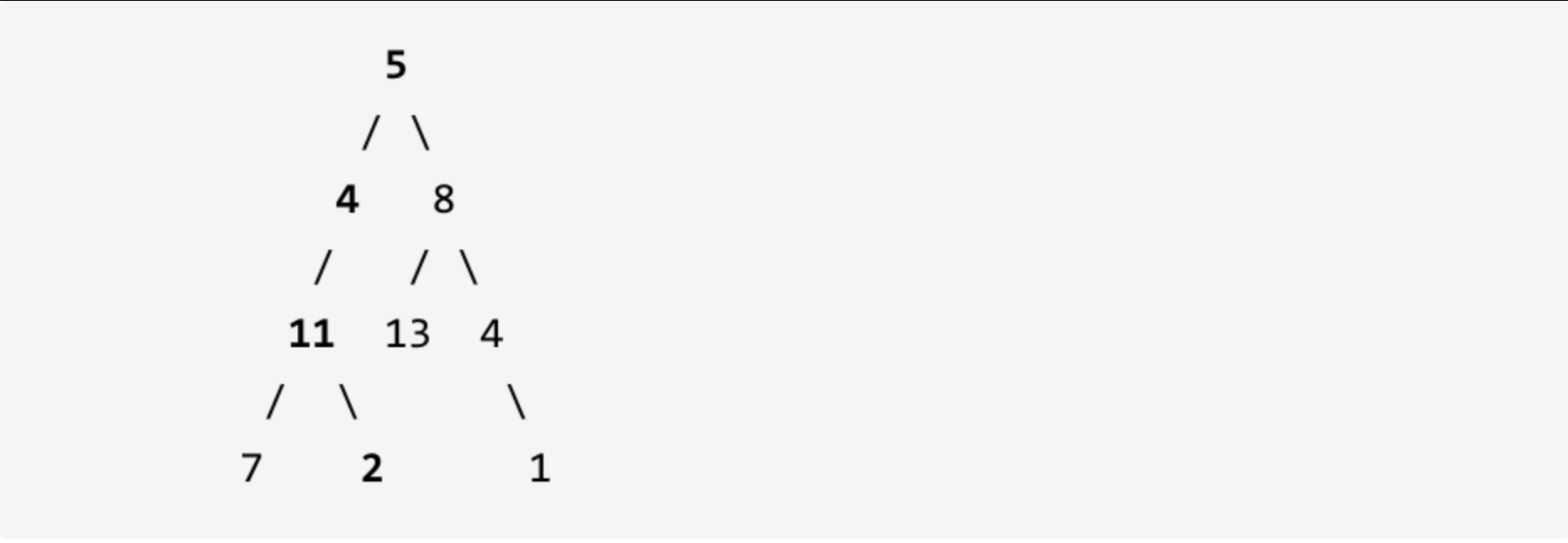DAY16||513.找树左下角的值 |路径总和|从中序与后序遍历序列构造二叉树
513.找树左下角的值
题目:513. 找树左下角的值 - 力扣(LeetCode)
给定一个二叉树的 根节点
root,请找出该二叉树的 最底层 最左边 节点的值。假设二叉树中至少有一个节点。
示例 1:
输入: root = [2,1,3] 输出: 1示例 2:
输入: [1,2,3,4,null,5,6,null,null,7] 输出: 7
递归法
前中后序都可以,因为没有中的处理逻辑。
回溯的思想体现在depth,要在递归语句前++,语句后--,其实就是回退的操作,去遍历右子树。
本题理解,找到最后一行的左节点就行,深度最大。
class Solution {
public:
int maxdepth=INT_MIN;
int result;
void trversal(TreeNode*root,int depth)
{
if(root->right==NULL&&root->left==NULL)//找到叶子节点,查看是否是最大深度的
{
if(depth>maxdepth)
{
maxdepth=depth;
result=root->val;
}
return;
}
if(root->left)
{
depth++;
trversal(root->left,depth);
depth--;
}
if(root->right)
{
depth++;
trversal(root->right,depth);
depth--;
}
return;
}
int findBottomLeftValue(TreeNode* root) {
trversal(root,0);
return result;
}
};迭代法
使用层序遍历比较简单。。
class Solution {
public:
int findBottomLeftValue(TreeNode* root) {
queue<TreeNode*>que;
int result=0;
if(root)que.push(root);
while(!que.empty())
{
int size=que.size();
for(int i=0;i<size;i++)
{
TreeNode*node=que.front();
que.pop();//其实没弹出一个结点,就弹进该节点的左右孩子
if(i==0)result=node->val;//记录最后一行第一个元素
if (node->left) que.push(node->left);
if (node->right) que.push(node->right);
}
}
return result;
}
};112.路径总和
给定一个二叉树和一个目标和,判断该树中是否存在根节点到叶子节点的路径,这条路径上所有节点值相加等于目标和。
说明: 叶子节点是指没有子节点的节点。
示例: 给定如下二叉树,以及目标和 sum = 22,
返回 true, 因为存在目标和为 22 的根节点到叶子节点的路径 5->4->11->2。
递归法
优先考虑深度优先遍历,前中后序都没有区别,因为没有中的处理逻辑。

累加判断是否等于的写法有点麻烦,可以用递减法,如果count等于0就说明找到了。
class Solution {
public:
bool traversal(TreeNode*cur,int count)
{
if(!cur->left&&!cur->right&&count==0)return true;//遇到叶子节点且count为0
if(!cur->left&&!cur->right)return false;//遇到叶子节点且count不为0
if(cur->left)
{
count-=cur->left->val;
if(traversal(cur->left,count))return true;//如果从下一层递归里得到1返回1
count+=cur->left->val;//回溯
}
if(cur->right)
{
count-=cur->right->val;
if(traversal(cur->right,count))return true;
count+=cur->right->val;//回溯
}
return false;
}
bool hasPathSum(TreeNode* root, int targetSum) {
if(root==NULL)return false;
return traversal(root,targetSum-root->val);
}
};迭代法可以用栈模拟回溯。
113.路径总和Ⅱ
给定一个二叉树和一个目标和,找到所有从根节点到叶子节点路径总和等于给定目标和的路径。
说明: 叶子节点是指没有子节点的节点。
要遍历整棵树,所以递归函数没有返回值。

class Solution {
public:
vector<vector<int>>result;
vector<int>path;
void traversal(TreeNode*cur,int count)
{
if(!cur->left&&!cur->right&&count==0)
{
result.push_back(path);
//找到一条路径
return;
}
if(!cur->left&&!cur->right)return;
if(cur->left)//左
{
count-=cur->left->val;
path.push_back(cur->left->val);
traversal(cur->left,count);
//回溯
count+=cur->left->val;
path.pop_back();
}
if(cur->right)//左
{
count-=cur->right->val;
path.push_back(cur->right->val);
traversal(cur->right,count);
//回溯
count+=cur->right->val;
path.pop_back();
}
return;
}
vector<vector<int>> pathSum(TreeNode* root, int targetSum) {
result.clear();
path.clear();
if(root==NULL)return result;
path.push_back(root->val);
traversal(root,targetSum-root->val);
return result;
}
};也比较简单。
106.从中序与后序遍历序列构造二叉树
题目:106. 从中序与后序遍历序列构造二叉树 - 力扣(LeetCode)
之前看过从中序和后序以及前序和中序构造二叉树的书本例子,所以本题理解起来不难,就是代码没有切实打过。中序是比较重要的,因为可以帮助我们区分左右子树。

来看一下一共分几步:
第一步:如果数组大小为零的话,说明是空节点了。
第二步:如果不为空,那么取后序数组最后一个元素作为节点元素。
第三步:找到后序数组最后一个元素在中序数组的位置,作为切割点
第四步:切割中序数组,切成中序左数组和中序右数组 (顺序别搞反了,一定是先切中序数组)
第五步:切割后序数组,切成后序左数组和后序右数组
第六步:递归处理左区间和右区间
代码注意点,切割中序数组时,首先从后序数组找到了最后一个元素,就是根节点,在中序数组找到,左右分割成左中序和右中序。再根据左右中序的大小,在后序数组切割相应大小的元素, 分割前部分为左后序,后部分为右后序。以此类推,递归构造二叉树。
代码
class Solution {
private:
TreeNode*traversal(vector<int>& inorder,vector<int>& postorder)
{
if(postorder.size()==0)return NULL;
int rootvalue=postorder[postorder.size()-1];//1.找到后序数组最后一个元素,即根节点
TreeNode*root=new TreeNode(rootvalue);
if(postorder.size()==1)return root;//如果只剩下叶子节点
int delimiterIndex;//找到分割点
for(delimiterIndex=0;delimiterIndex<inorder.size();delimiterIndex++)
{
if(inorder[delimiterIndex]==rootvalue)break;
}
vector<int>leftinorder(inorder.begin(),inorder.begin()+delimiterIndex);//切割中序数组,左闭右开写法
vector<int>rightinorder(inorder.begin()+delimiterIndex+1,inorder.end());//注意这里是+1!
postorder.resize(postorder.size()-1);//移除后序数组最后一个元素
//切割后序数组,注意后序和中序大小一样,所以可以以上步求得的左右中序数组大小作为分割
vector<int>leftpostorder(postorder.begin(),postorder.begin()+leftinorder.size());
vector<int>rightpostorder(postorder.begin()+leftinorder.size(),postorder.end());
root->left=traversal(leftinorder,leftpostorder);//传入新的左中序和左后序,继续构造左右子树
root->right=traversal(rightinorder,rightpostorder);
return root;
}
public:
TreeNode* buildTree(vector<int>& inorder, vector<int>& postorder) {
if(inorder.size()==0||postorder.size()==0)return NULL;
return traversal(inorder,postorder);
}
};今天的还行吧。没有特别难,基本都能自己写出来,但是细节还要多注意。
原文地址:https://blog.csdn.net/2301_79865280/article/details/142581095
免责声明:本站文章内容转载自网络资源,如本站内容侵犯了原著者的合法权益,可联系本站删除。更多内容请关注自学内容网(zxcms.com)!



